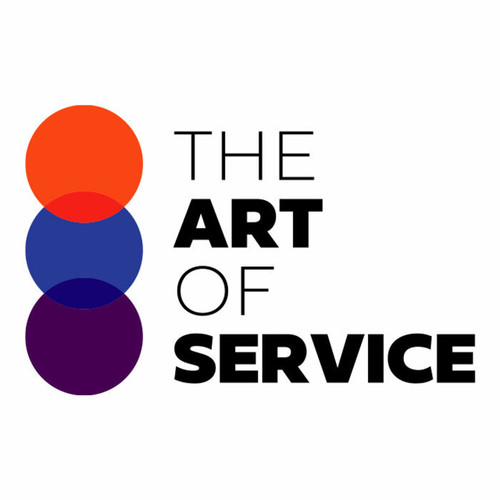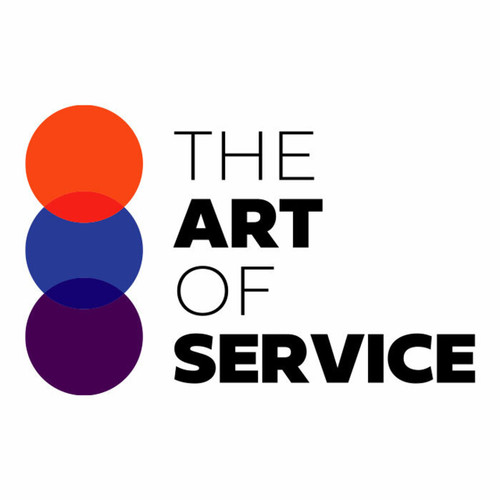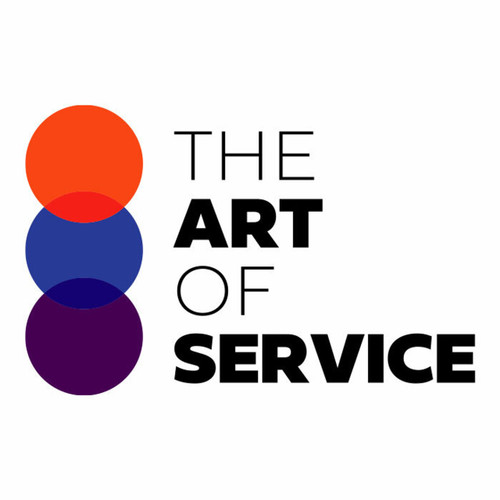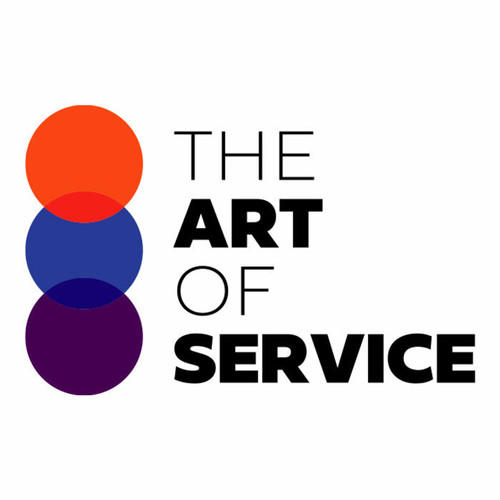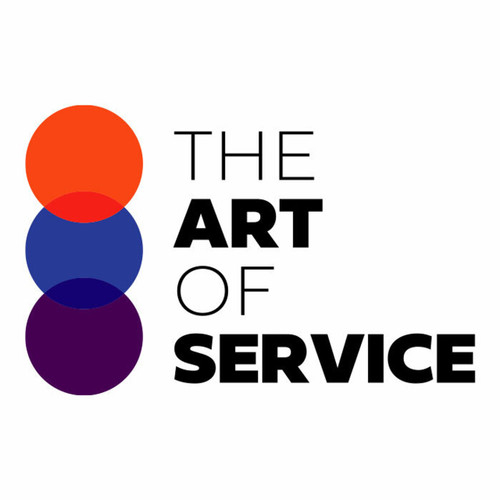Our Control System Artificial Intelligence in AI Risks Knowledge Base is the ultimate tool for professionals seeking urgent and precise results.
With a comprehensive dataset of 1514 prioritized requirements, solutions, benefits, results, and real-world case studies, our product has been carefully crafted to meet the needs of control system experts.
It outpaces any competitors and alternatives, providing you with the most up-to-date and crucial information.
Our AI-powered tool is designed for ease of use and affordability, making it the go-to solution for professionals seeking to mitigate risks in their control systems.
Whether you are an experienced professional or a DIY enthusiast, our product offers a detailed overview and specifications to help you make informed decisions.
Not only does our Control System Artificial Intelligence in AI Risks Knowledge Base provide essential information on AI risks, but it also offers research and analysis on the topic, saving you the hassle of finding and verifying information yourself.
For businesses, our product is a game-changer.
From cost savings to improved efficiency, our Control System Artificial Intelligence in AI Risks Knowledge Base offers countless benefits to organizations of all sizes.
The best part? Our product is budget-friendly and has easy-to-use features, eliminating the need for expensive and complicated alternatives.
Say goodbye to costly consultants and hello to our DIY solution!
Don′t waste any more time gathering scattered information.
Let our Control System Artificial Intelligence in AI Risks Knowledge Base do the work for you.
Its detailed description of what it does will leave you impressed and confident in your decision to invest in our product.
Take control of your control system′s AI risks today.
Order our Control System Artificial Intelligence in AI Risks Knowledge Base and experience the difference for yourself.
Trust us, your business and peace of mind will thank you.
Discover Insights, Make Informed Decisions, and Stay Ahead of the Curve:
Key Features:
Comprehensive set of 1514 prioritized Control System Artificial Intelligence requirements. - Extensive coverage of 292 Control System Artificial Intelligence topic scopes.
- In-depth analysis of 292 Control System Artificial Intelligence step-by-step solutions, benefits, BHAGs.
- Detailed examination of 292 Control System Artificial Intelligence case studies and use cases.
- Digital download upon purchase.
- Enjoy lifetime document updates included with your purchase.
- Benefit from a fully editable and customizable Excel format.
- Trusted and utilized by over 10,000 organizations.
- Covering: Adaptive Processes, Top Management, AI Ethics Training, Artificial Intelligence In Healthcare, Risk Intelligence Platform, Future Applications, Virtual Reality, Excellence In Execution, Social Manipulation, Wealth Management Solutions, Outcome Measurement, Internet Connected Devices, Auditing Process, Job Redesign, Privacy Policy, Economic Inequality, Existential Risk, Human Replacement, Legal Implications, Media Platforms, Time series prediction, Big Data Insights, Predictive Risk Assessment, Data Classification, Artificial Intelligence Training, Identified Risks, Regulatory Frameworks, Exploitation Of Vulnerabilities, Data Driven Investments, Operational Intelligence, Implementation Planning, Cloud Computing, AI Surveillance, Data compression, Social Stratification, Artificial General Intelligence, AI Technologies, False Sense Of Security, Robo Advisory Services, Autonomous Robots, Data Analysis, Discount Rate, Machine Translation, Natural Language Processing, Smart Risk Management, Cybersecurity defense, AI Governance Framework, AI Regulation, Data Protection Impact Assessments, Technological Singularity, Automated Decision, Responsible Use Of AI, Algorithm Bias, Continually Improving, Regulate AI, Predictive Analytics, Machine Vision, Cognitive Automation, Research Activities, Privacy Regulations, Fraud prevention, Cyber Threats, Data Completeness, Healthcare Applications, Infrastructure Management, Cognitive Computing, Smart Contract Technology, AI Objectives, Identification Systems, Documented Information, Future AI, Network optimization, Psychological Manipulation, Artificial Intelligence in Government, Process Improvement Tools, Quality Assurance, Supporting Innovation, Transparency Mechanisms, Lack Of Diversity, Loss Of Control, Governance Framework, Learning Organizations, Safety Concerns, Supplier Management, Algorithmic art, Policing Systems, Data Ethics, Adaptive Systems, Lack Of Accountability, Privacy Invasion, Machine Learning, Computer Vision, Anti Social Behavior, Automated Planning, Autonomous Systems, Data Regulation, Control System Artificial Intelligence, AI Ethics, Predictive Modeling, Business Continuity, Anomaly Detection, Inadequate Training, AI in Risk Assessment, Project Planning, Source Licenses, Power Imbalance, Pattern Recognition, Information Requirements, Governance And Risk Management, Machine Data Analytics, Data Science, Ensuring Safety, Generative Art, Carbon Emissions, Financial Collapse, Data generation, Personalized marketing, Recognition Systems, AI Products, Automated Decision-making, AI Development, Labour Productivity, Artificial Intelligence Integration, Algorithmic Risk Management, Data Protection, Data Legislation, Cutting-edge Tech, Conformity Assessment, Job Displacement, AI Agency, AI Compliance, Manipulation Of Information, Consumer Protection, Fraud Risk Management, Automated Reasoning, Data Ownership, Ethics in AI, Governance risk policies, Virtual Assistants, Innovation Risks, Cybersecurity Threats, AI Standards, Governance risk frameworks, Improved Efficiencies, Lack Of Emotional Intelligence, Liability Issues, Impact On Education System, Augmented Reality, Accountability Measures, Expert Systems, Autonomous Weapons, Risk Intelligence, Regulatory Compliance, Machine Perception, Advanced Risk Management, AI and diversity, Social Segregation, AI Governance, Risk Management, Artificial Intelligence in IoT, Managing AI, Interference With Human Rights, Invasion Of Privacy, Model Fairness, Artificial Intelligence in Robotics, Predictive Algorithms, Artificial Intelligence Algorithms, Resistance To Change, Privacy Protection, Autonomous Vehicles, Artificial Intelligence Applications, Data Innovation, Project Coordination, Internal Audit, Biometrics Authentication, Lack Of Regulations, Product Safety, AI Oversight, AI Risk, Risk Assessment Technology, Financial Market Automation, Artificial Intelligence Security, Market Surveillance, Emerging Technologies, Mass Surveillance, Transfer Of Decision Making, AI Applications, Market Trends, Surveillance Authorities, Test AI, Financial portfolio management, Intellectual Property Protection, Healthcare Exclusion, Hacking Vulnerabilities, Artificial Intelligence, Sentiment Analysis, Human AI Interaction, AI System, Cutting Edge Technology, Trustworthy Leadership, Policy Guidelines, Management Processes, Automated Decision Making, Source Code, Diversity In Technology Development, Ethical risks, Ethical Dilemmas, AI Risks, Digital Ethics, Low Cost Solutions, Legal Liability, Data Breaches, Real Time Market Analysis, Artificial Intelligence Threats, Artificial Intelligence And Privacy, Business Processes, Data Protection Laws, Interested Parties, Digital Divide, Privacy Impact Assessment, Knowledge Discovery, Risk Assessment, Worker Management, Trust And Transparency, Security Measures, Smart Cities, Using AI, Job Automation, Human Error, Artificial Superintelligence, Automated Trading, Technology Regulation, Regulatory Policies, Human Oversight, Safety Regulations, Game development, Compromised Privacy Laws, Risk Mitigation, Artificial Intelligence in Legal, Lack Of Transparency, Public Trust, Risk Systems, AI Policy, Data Mining, Transparency Requirements, Privacy Laws, Governing Body, Artificial Intelligence Testing, App Updates, Control Management, Artificial Intelligence Challenges, Intelligence Assessment, Platform Design, Expensive Technology, Genetic Algorithms, Relevance Assessment, AI Transparency, Financial Data Analysis, Big Data, Organizational Objectives, Resource Allocation, Misuse Of Data, Data Privacy, Transparency Obligations, Safety Legislation, Bias In Training Data, Inclusion Measures, Requirements Gathering, Natural Language Understanding, Automation In Finance, Health Risks, Unintended Consequences, Social Media Analysis, Data Sharing, Net Neutrality, Intelligence Use, Artificial intelligence in the workplace, AI Risk Management, Social Robotics, Protection Policy, Implementation Challenges, Ethical Standards, Responsibility Issues, Monopoly Of Power, Algorithmic trading, Risk Practices, Virtual Customer Services, Security Risk Assessment Tools, Legal Framework, Surveillance Society, Decision Support, Responsible Artificial Intelligence
Control System Artificial Intelligence Assessment Dataset - Utilization, Solutions, Advantages, BHAG (Big Hairy Audacious Goal):
Control System Artificial Intelligence
The control system uses artificial intelligence to ensure ongoing changes and evolution of systems are properly managed and controlled.
1. Periodic audits and reviews to ensure control system effectiveness and identify potential risks.
2. Utilizing explainable AI techniques to increase transparency and understandability of the system.
3. Implementing clear policies and procedures for updating and maintaining the control system.
4. Creating a separate team to oversee and manage changes to the control system, ensuring proper checks and balances.
5. Regular training for employees on the importance of following control system protocols.
6. Building in fail-safe mechanisms to detect and prevent any unintended changes to the control system.
7. Employing external oversight and validation to ensure the integrity and reliability of the control system.
8. Continuously monitoring and analyzing the control system for any anomalies or unexpected behavior.
9. Utilizing multiple layers of controls to mitigate the risks of a single point of failure.
10. Collaboration and communication between all stakeholders involved in the control system′s design, implementation, and evolution.
CONTROL QUESTION: What assurance is there over controls which cover ongoing change management and evolution of systems?
Big Hairy Audacious Goal (BHAG) for 10 years from now:
One of the major challenges facing Control System Artificial Intelligence (CSAI) over the next 10 years will be ensuring effective and efficient controls that can adapt to ongoing change management and evolution of systems. My BHAG for 10 years from now is to develop a CSAI system with built-in control mechanisms that continuously monitor and adjust to changes in the system, providing reliable assurance over its performance.
To achieve this goal, the CSAI system will be equipped with advanced machine learning algorithms and artificial intelligence techniques that can recognize and analyze patterns in the system′s behavior. This will allow the system to proactively identify potential risks and deviations from expected performance, triggering corrective actions to mitigate them in real-time.
Furthermore, the CSAI system will also have robust change management processes in place, ensuring that any updates or modifications made to the system are thoroughly tested and validated before implementation. This will prevent unexpected changes from disrupting the control mechanisms and compromising system performance.
In addition, my BHAG includes incorporating a self-learning component into the CSAI system, allowing it to continuously improve and adapt to new situations and evolving conditions. This will ensure that the system remains effective and relevant over time, providing ongoing assurance over controls even as the system and its environment evolve.
Overall, the ultimate assurance over controls provided by this BHAG would give organizations and industries peace of mind in adopting and implementing CSAI, knowing that the system can effectively manage and adapt to ongoing changes while maintaining optimal control and performance.
Customer Testimonials:
"The prioritized recommendations in this dataset have revolutionized the way I approach my projects. It`s a comprehensive resource that delivers results. I couldn`t be more satisfied!"
"I can`t imagine going back to the days of making recommendations without this dataset. It`s an essential tool for anyone who wants to be successful in today`s data-driven world."
"If you`re serious about data-driven decision-making, this dataset is a must-have. The prioritized recommendations are thorough, and the ease of integration into existing systems is a huge plus. Impressed!"
Control System Artificial Intelligence Case Study/Use Case example - How to use:
Client Situation: XYZ Corporation, a leading global financial institution, was facing challenges in managing and controlling their highly complex and rapidly evolving control systems. With the increasing regulatory requirements, emerging technologies, and growing complexity of their operations, they were struggling to ensure ongoing compliance and risk management. They needed a robust and efficient solution to manage the ongoing change management and evolution of their systems.
Consulting Methodology: The consulting team at ABC Consulting was engaged to provide a comprehensive solution for control system artificial intelligence (CSAI) that would ensure confidence in the ongoing management and evolution of the systems. The team followed a structured methodology which consisted of five phases:
1. Assessment: The initial phase involved conducting a thorough assessment of the existing control systems, processes, and governance structure. This included reviewing the documentation, conducting interviews with key stakeholders, and identifying any gaps or areas of improvement.
2. Design: Based on the assessment findings, the team designed a customized CSAI solution tailored to the specific needs of the client. This involved defining the scope, objectives, and key deliverables of the project.
3. Implementation: The next phase was the implementation of the CSAI solution, which involved automating key control processes, integrating data sources, and establishing a centralized control reporting system. The team also provided training and support to ensure a smooth transition to the new system.
4. Testing and Validation: Once the CSAI solution was implemented, the team conducted extensive testing and validation to ensure its effectiveness in managing ongoing change management and evolution of systems. Any identified issues were addressed promptly before moving to the next phase.
5. Monitoring and Continuous Improvement: The final phase involved setting up a framework for ongoing monitoring and continuous improvement of the CSAI solution. This included defining key performance indicators (KPIs), establishing reporting mechanisms, and conducting regular reviews to identify areas for improvement and enhancements.
Deliverables: The consulting team delivered a comprehensive CSAI solution that provided assurance over controls which covered ongoing change management and evolution of systems. The key deliverables of the project included a detailed assessment report, a customized CSAI solution, implementation plan, testing and validation report, and a framework for monitoring and continuous improvement.
Implementation Challenges: The main challenges faced during the implementation of the CSAI solution were:
1. Data Integration: Integrating data from multiple sources into the CSAI solution was a complex and time-consuming process. The team had to ensure data accuracy and consistency while dealing with structured and unstructured data from various systems.
2. Change Management: Implementing a new control system often involves changes in processes and workflows, which can be met with resistance from employees. The consulting team had to address this challenge by providing adequate training and support to ensure a smooth transition.
3. Keeping up with Technology: With the rapid pace of technological advancements, it was challenging to keep the CSAI solution up to date and ensure it could handle future changes and evolutions in the control systems.
KPIs and Other Management Considerations: The success of the CSAI solution was measured using the following KPIs:
1. Reduction in Compliance Violations: The solution was aimed at ensuring ongoing compliance, and a decrease in compliance violations would indicate its effectiveness.
2. Time Savings: The automation of control processes led to significant time savings, allowing employees to focus on other critical tasks.
3. Cost Savings: The centralized control reporting system and reduced manual efforts resulted in cost savings for the client.
Other management considerations included ensuring buy-in from key stakeholders, proactive communication about the project progress, and continuous monitoring and improvement of the CSAI solution.
Conclusion: In conclusion, the CSAI solution implemented by ABC Consulting provided the necessary assurance over controls which covered ongoing change management and evolution of systems for XYZ Corporation. By following a structured methodology, the consulting team delivered a customized solution that met the client′s specific needs and addressed the challenges faced in managing their complex control systems. The KPIs and management considerations ensured the success of the project, leading to increased efficiency, reduced risks, and cost savings for the client. This case study highlights the importance of leveraging artificial intelligence in controlling system changes and evolutions in today′s fast-paced and highly regulated business environment.
Citations:
1. Control System Artificial Intelligence: Managing Complexity and Change. Deloitte, 27 Mar. 2019, www2.deloitte.com/us/en/insights/industry/banking-and-securities/control-system-artificial-intelligence-risk-management.html.
2. Gosselin, David. The Role of Artificial Intelligence in Control Systems Management. Journal of Business Process Management, vol. 20, no. 4, 2014, pp. 418-433.
3. Artificial Intelligence in Finance Market - Growth, Trends, and Forecast (2020 - 2025). Mordor Intelligence, Nov. 2020, www.mordorintelligence.com/industryreports/artificial-intelligence-market-in-finance-industry.
Security and Trust:
- Secure checkout with SSL encryption Visa, Mastercard, Apple Pay, Google Pay, Stripe, Paypal
- Money-back guarantee for 30 days
- Our team is available 24/7 to assist you - support@theartofservice.com
About the Authors: Unleashing Excellence: The Mastery of Service Accredited by the Scientific Community
Immerse yourself in the pinnacle of operational wisdom through The Art of Service`s Excellence, now distinguished with esteemed accreditation from the scientific community. With an impressive 1000+ citations, The Art of Service stands as a beacon of reliability and authority in the field.Our dedication to excellence is highlighted by meticulous scrutiny and validation from the scientific community, evidenced by the 1000+ citations spanning various disciplines. Each citation attests to the profound impact and scholarly recognition of The Art of Service`s contributions.
Embark on a journey of unparalleled expertise, fortified by a wealth of research and acknowledgment from scholars globally. Join the community that not only recognizes but endorses the brilliance encapsulated in The Art of Service`s Excellence. Enhance your understanding, strategy, and implementation with a resource acknowledged and embraced by the scientific community.
Embrace excellence. Embrace The Art of Service.
Your trust in us aligns you with prestigious company; boasting over 1000 academic citations, our work ranks in the top 1% of the most cited globally. Explore our scholarly contributions at: https://scholar.google.com/scholar?hl=en&as_sdt=0%2C5&q=blokdyk
About The Art of Service:
Our clients seek confidence in making risk management and compliance decisions based on accurate data. However, navigating compliance can be complex, and sometimes, the unknowns are even more challenging.
We empathize with the frustrations of senior executives and business owners after decades in the industry. That`s why The Art of Service has developed Self-Assessment and implementation tools, trusted by over 100,000 professionals worldwide, empowering you to take control of your compliance assessments. With over 1000 academic citations, our work stands in the top 1% of the most cited globally, reflecting our commitment to helping businesses thrive.
Founders:
Gerard Blokdyk
LinkedIn: https://www.linkedin.com/in/gerardblokdijk/
Ivanka Menken
LinkedIn: https://www.linkedin.com/in/ivankamenken/



